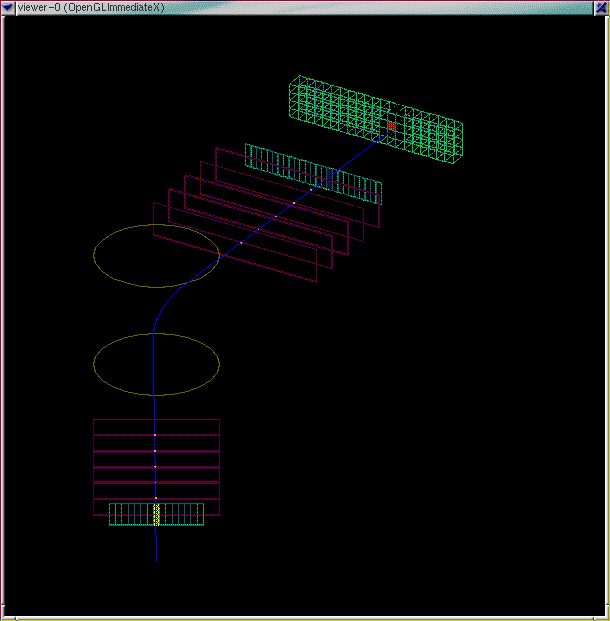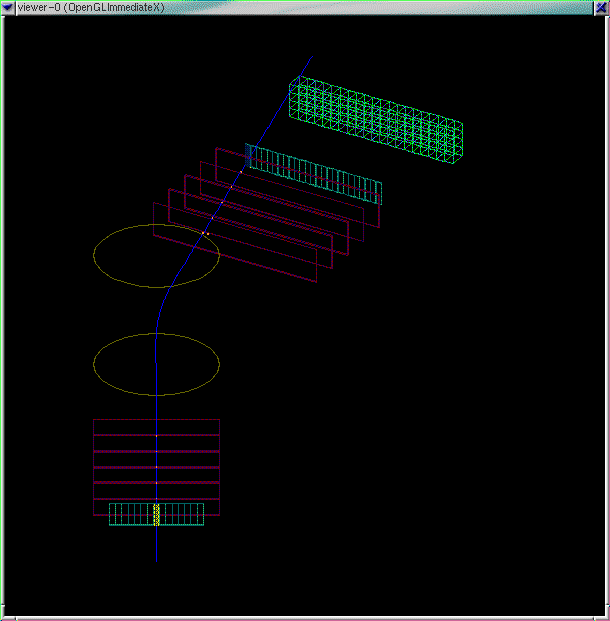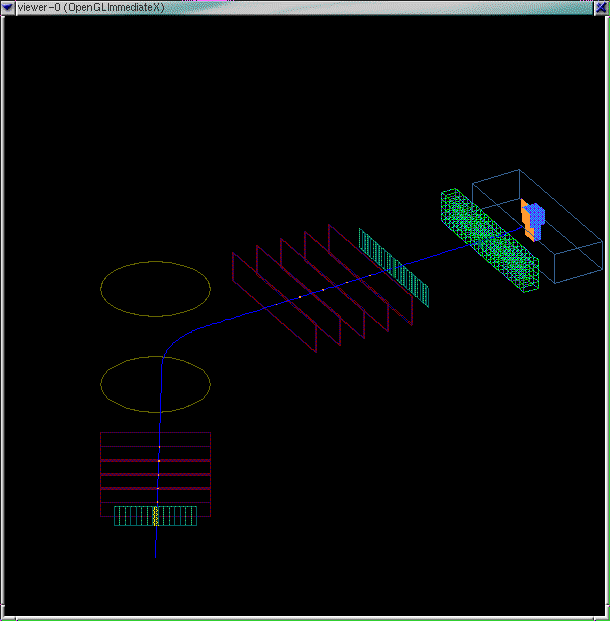CSC Geant4 Tutorial
Introduction - Setting the environment to use Geant4
The Geant4 source code and kernel libraries are installed in /CSC2/apps/staff/gcosmo/geant4.
The version installed is Geant4 2.0 + patch01.
To configure your environment to use Geant4, you need to execute the
following shell script
(example for tcsh):
source /CSC2/apps/staff/gcosmo/config.csh
The script will configure the environment and set all necessary paths to
retrieve Geant4 associated tools.
The Geant4 hodoscope exercise
Introduction
The example CSCG4Ex has a simplified fixed-target detector geometry
which consists of two arms before and after the magnetic field region.
The first arm has a scintillator hodoscope plane and five layers of chambers.
The second arm can be rotated and has a scintillator hodoscope plane, five
layers of chambers and an array of CsI EM calorimeter. Students are expected
to add a hadronic calorimeter made of lead/scintillator down-stream to
the EM calorimeter.
Building the exercise
Retrieve the code of the hodoscope's exercise from the installation area,
by doing the following:
cp -r /CSC2/apps/staff/gcosmo/work $HOME
After configured your environment as described above, start building the
Geant4 application:
cd $HOME/work/CSC
gmake
rehash
All Geant4 user applications are structured as following:
A directory include containing all class header files
(*.hh) and/or inline function implementation files (*.icc).
A director src containing all class implementation sources
(*.cc).
A source file, whose name corresponds to the user's application name
and including the main body (CSCG4Ex.cc).
A GNUmakefile script for building the application.
One or more input macro files (*.mac) to be used interactively
or in batch-mode as input to the application.
Once the user code has been compiled, the final executable is placed in
$G4WORKDIR/bin/$G4SYSTEM
ready to be used. All temporary objects files are placed in $G4WORKDIR/tmp/$G4SYSTEM.
To remove the compiled objects for the exercise, one should just do
the following:
cd $HOME/work/CSC
gmake clean
Running the exercise
Check that your terminal display is correctly set:
setenv DISPLAY <my-display-ID>
Once compiled the user code in $HOME/work/CSC as described above,
just invoke the application from $HOME/work/CSC:
CSCG4Ex
Geant4 will start the initialisation phase. Once you get the prompt, you
can run one of the input macros provided with the example. For example,
to start a graphical session with a predefined set of simulated events,
type:
/control/execute sample1.mac
After the macro will be completely executed the prompt will be returned.

The executable image can be run in both interactive and batch modes.
Three sample macro files demonstrate the basic features of this example:
sample1.mac
and sample3.mac are macros involving visualization, while sample2.mac
is a batch script producing up to 3000 events. To run the executable in
batch mode, add a macro file name as argumnent to the application CSCG4Ex.
For example, try the following:
CSCG4Ex sample2.mac
UI commands defined for this example
/mydet/armAngle
Rotation angle of the second arm.
/mydet/fieldValue
Field strength
/mydet/momentum
Mean momentum of primaries
/mydet/sigmaMomentum
Sigma momentum of primaries
/mydet/sigmaAngle
Sigma angle divergence of primaries
/mydet/randomizePrimary
Boolean flag for randomizing primary
particle types.
/mydet/verbose
Verbose level for each event.


Brief descriptions of classes
Main
CSCG4Ex
The main() method which constructs G4RunManager, CSCG4ExVisManager (derived
class of G4VVisManager), G4UIterminal and some user classes.
User mandatory classes
CSCG4ExDetectorConstruction (derived from G4VUserDetectorConstruction)
This class constructs all materials and detector geometry. Sensitive detectors
are also constructed and attached to the logical volumes.
Geometry of the detectors are defined by three ways, ordinary placement,
parameterisation and replica.
This class also has a capability of changing geometry between two runs.
CSCG4ExPhysicsList (derived from G4VUserPhysicsList)
This class constructs all ordinary applicable particles and physics processes
of electro-magnetic and hadronic interactions, decays and
transportation. The range cut-off is set to 1 mm.
CSCG4ExPrimaryGeneratorAction (derived from G4VUserPrimaryGeneratorAction)
This class shoots one primary particle for one event. Momentum, direction
and particle type of the primary are randomized.
Geometry related classes
CSCG4ExMagneticField (derived from G4MagneticField)
This class define the magnetic field and its strength.
CSCG4ExCellParameterisation (derived from G4VPVParameterisation)
This class defines the parameterisation scheme of CsI EM calorimeter cells.
Optional user action classes
CSCG4ExEventAction (derived from G4UserEventAction)
This class defines a simple analysis routine executed at the end of each
event.
CSCG4ExTrackingAction (derived from G4UserTrackingAction)
This class sets a flag of G4TrackingManager for generating a trajectory
only if the currently processing particle is a primary particle.
Hits and sensitive detector classes
CSCG4ExHodoscopeHit (derived from G4VHit) and CSCG4ExHodoscope
(derived from G4VSensitiveDetector)
CSCG4ExHodoscopeHit object stores the finger ID number and the time. It
also stores the position, rotation matrix and a pointer to the logical
volume of the finger for the sake of drawing.
CSCG4ExHodoscope creates CSCG4ExHodoscopeHit objects.
CSCG4ExDriftChamberHit (derived from G4VHit) and CSCG4ExDriftChamber
(derived from G4VSensitiveDetector)
CSCG4ExDriftChamberHit object stores the layer ID number, local and global
coordinates of the hit position and time. CSCG4ExDriftChamber constructs
CSCG4ExDriftChamberHit objects.
CSCG4ExEmCalorimeterHit (derived from G4VHit) and CSCG4ExEmCalorimeter
(derived from G4VSensitiveDetector)
CSCG4ExEmCalorimeterHit object stores the row and column ID numbers of
the cell and sum of the energy deposited in the cell. It also stores the
position, rotation matrix and a pointer to the logical volume of the cell
for drawing purposes.
The color of drawn hit cell depends on the deposited energy.
CSCG4ExEmCalorimeter creates CSCG4ExEmCalorimeterHit objects.
Visualization and GUI classes
CSCG4ExVisManager (derived from G4VisManager)
This class defines the visualization drivers used in this program.
CSCG4ExDetectorConstMessenger, CSCG4ExEventActionMessenger,
CSCG4ExMagneticFieldMessenger and CSCG4ExPrimaryGeneratorMessenger (derived
from G4UImessenger)
These classes are the messenger classes which define UI commands to be
invoked at run-time.
Exercises
Exercise 1
- compile, link and execute the example
- understanding Geant4: modify the verbose level, run
commands
- draw secondaries
Exercise 2
- modify the calorimeter geometry:
implementation of a
Pb/Scinti Hadron calorimeter
Exercise 3
- handling simulation outputs:
addition of a Hadron calorimeter sensitive
detector.
Here is how an event displayed with the additional hadron calorimeter
should look like:

The archived source code for the exercise (with solutions) is available
here.
All the information about the Geant4 toolkit can be found online from the
World Wide Web: http://cern.ch/geant4
Makoto Asai, Gabriele Cosmo, Mark Verderi - Last
modified: Saturday, September 23, 2000




